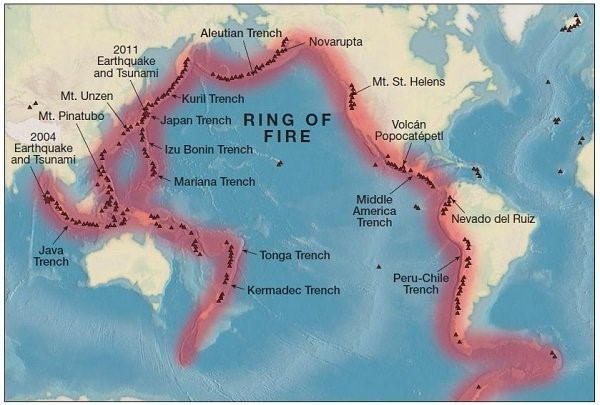Context:
Mount Adams, Washington’s largest volcano, has recently shown a surge in seismic activity after remaining largely dormant for thousands of years.
Relevance:
GS I: Geography
Dimensions of the Article:
- About Mount Adams
- Stratovolcano
- About the Ring of Fire
About Mount Adams:
- Mount Adams is a stratovolcano in the state of Washington, United States. Mount Adams is a giant active volcano in the State of Washington. Standing at 12,277 feet (3,742 meters) in elevation, it has a diameter of 18 miles (29 kilometers). It is bigger in volume than Rainier, which stands as the highest peak in the state.
- Mount Adams is situated in the Mount Adams volcanic field, a 1,250 sq. km area which has at least 120, mainly basaltic volcanoes that are composed of spatter and scoria cones, shield volcanoes, and some large lava flows.
- There are over 10 active glaciers covering Mount Adams that provide water to the forests, streams, and meadows below.
- The last eruption at the site occurred between 3,800 and 7,600 years ago when mankind was still living in the Stone Age.
Stratovolcano
- A stratovolcano, also known as a composite volcano, is a conical volcano built up by many layers (strata) of hardened lava and tephra.
- Unlike shield volcanoes, stratovolcanoes are characterized by a steep profile with a summit crater and periodic intervals of explosive eruptions and effusive eruptions, although some have collapsed summit craters called calderas.
- The lava flowing from stratovolcanoes typically cools and hardens before spreading far, due to high viscosity.
- The magma forming this lava is often felsic, having high-to-intermediate levels of silica (as in rhyolite, dacite, or andesite), with lesser amounts of less-viscous mafic magma.
- Stratovolcanoes are sometimes called “composite volcanoes” because of their composite stratified structure built up from sequential outpourings of erupted materials.
- They are among the most common types of volcanoes, in contrast to the less common shield volcanoes.
- Two famous examples of stratovolcanoes are Krakatoa in Indonesia, known for its catastrophic eruption in 1883, and Vesuvius in Italy, whose catastrophic eruption in AD 79 buried the Roman cities of Pompeii and Herculaneum.
- In modern times, Mount St. Helens in Washington State, USA and Mount Pinatubo in the Philippines have erupted catastrophically, but with fewer deaths.
About the Ring of Fire

- Many volcanoes in the Ring of Fire were created through a process of subduction. And most of the planet’s subduction zones happen to be located in the Ring of Fire
- It is a string of at least 450 active and dormant volcanoes that form a semi-circle, or horse shoe, around the Philippine Sea plate, the Pacific Plate, Juan de Fuca and Cocos plates, and the Nazca Plate.
- There is a lot of seismic activity in the area.
- 90 per cent of all earthquakes strike within the Ring of Fire
Why are there so many volcanoes in the Ring of Fire?
- The tectonic plates move non-stop over a layer of partly solid and partly molten rock which is called the Earth’s mantle.
- When the plates collide or move apart, for instance, the Earth moves, literally.
- Mountains, like the Andes in South America and the Rockies in North America, as well as volcanoes have formed through the collision of tectonic plates.
- Many volcanoes in the Ring of Fire were created through a process of subduction. And most of the planet’s subduction zones happen to be located in the Ring of Fire
-Source: Indian Express


